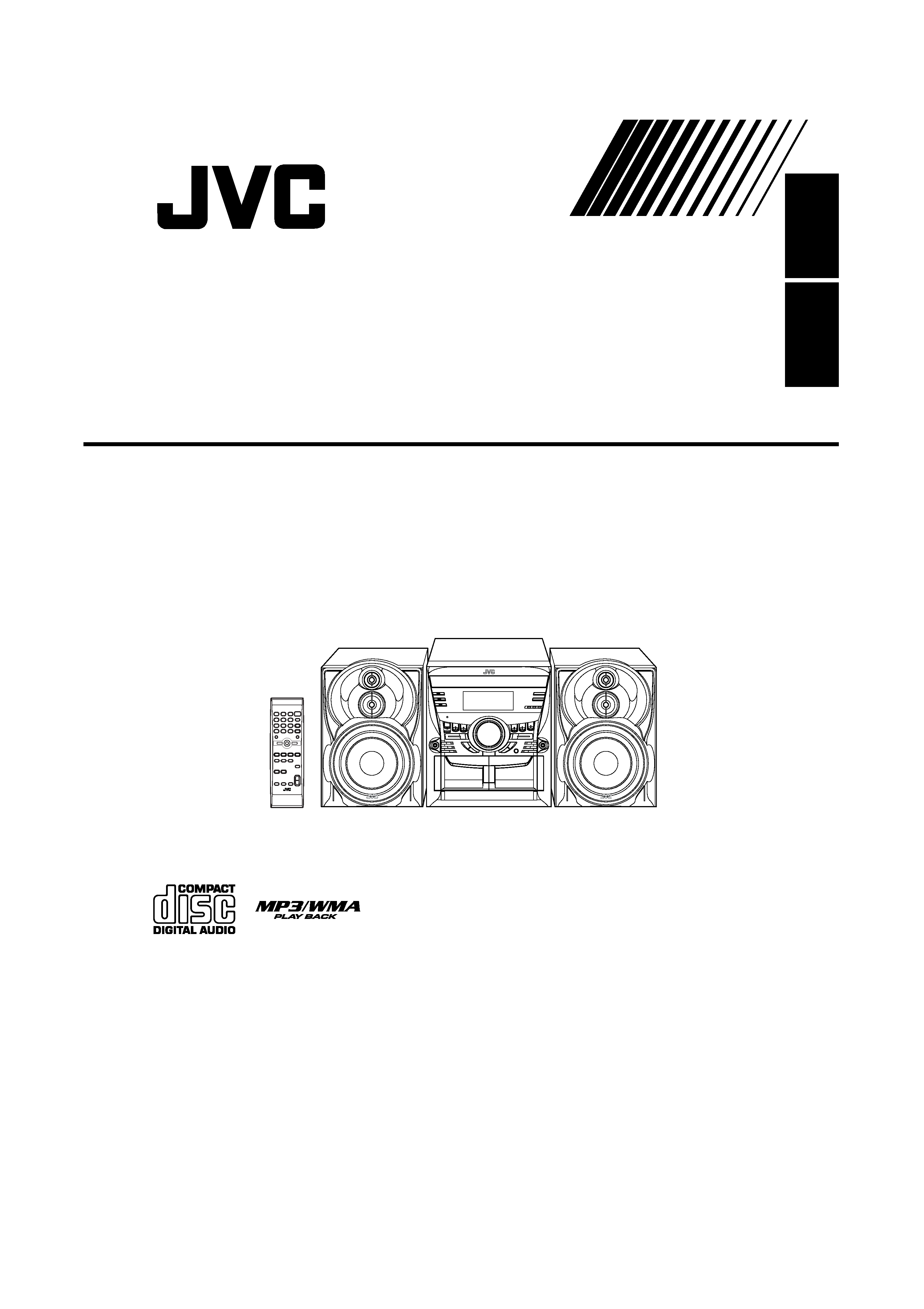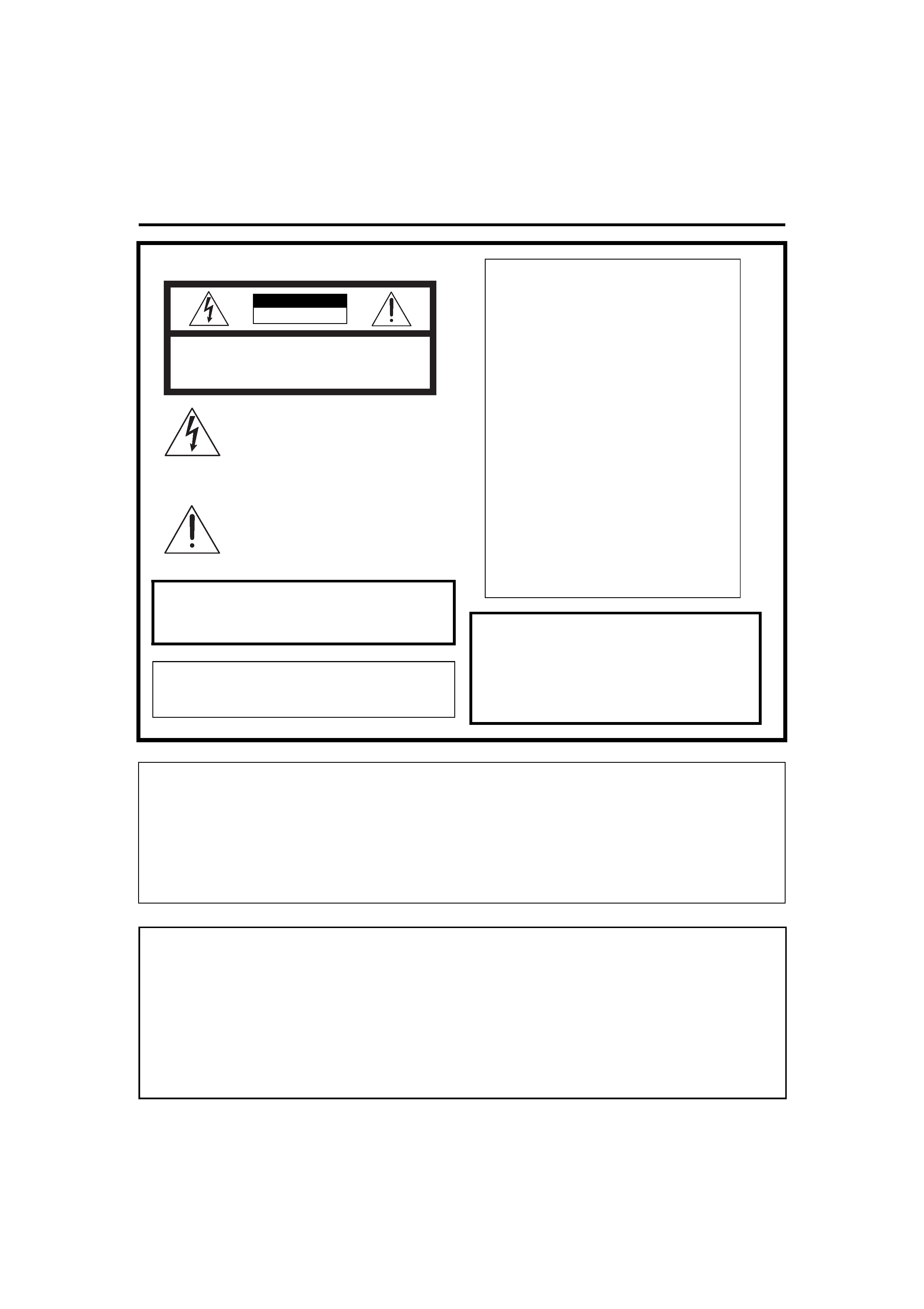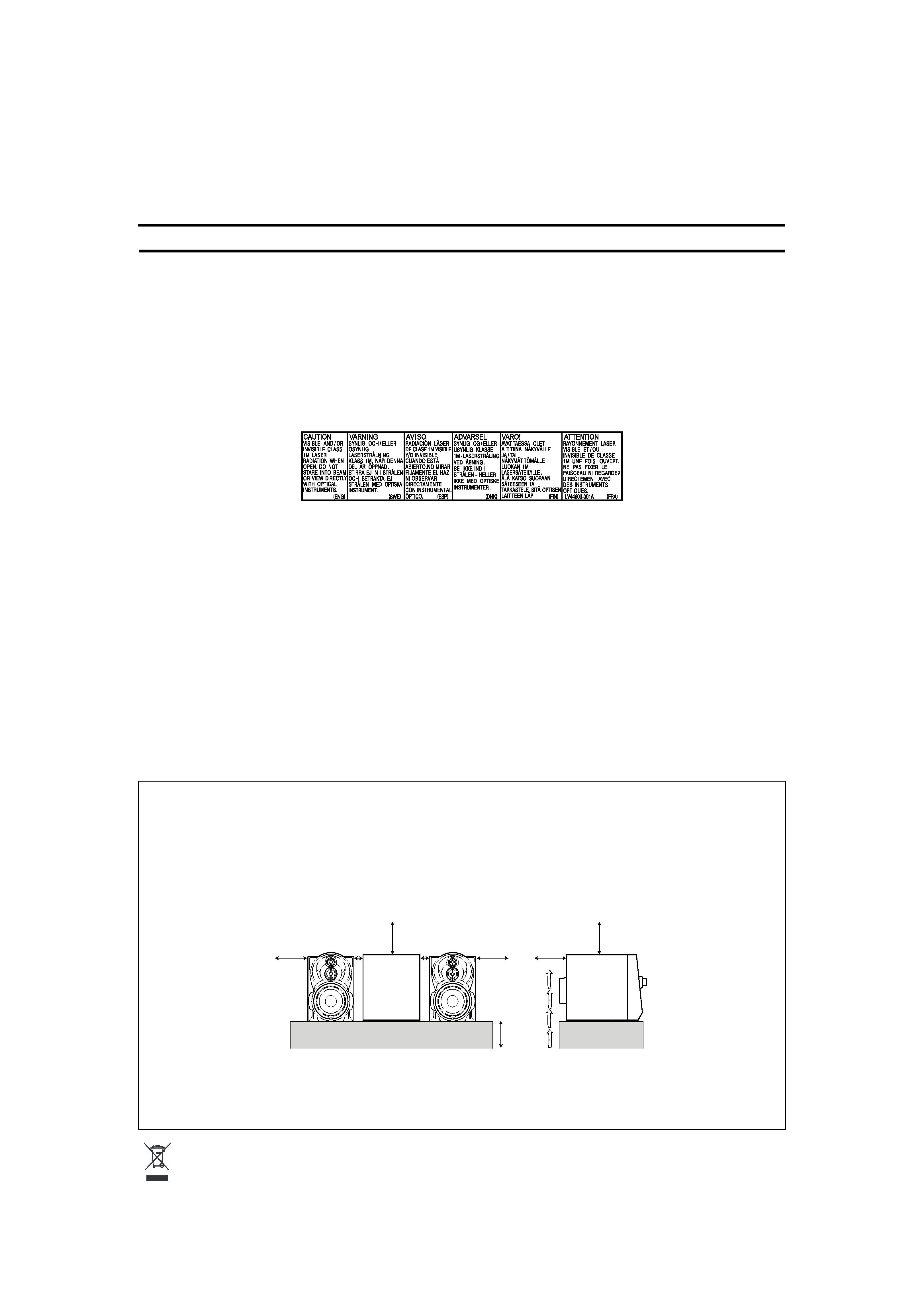
En
glish
Français
LVT1521-002A
[C]
COMPACT COMPONENT SYSTEM
SYSTEME DE COMPOSANTS COMPACT
SP-MXKC45
CA-MXKC45
CA-MXKC45
INSTRUCTIONS
MANUEL D'INSTRUCTIONS
MX-KC45
Consists of CA-MXKC45 and SP-MXKC45
Se compose de CA-MXKC45 et de SP-MXKC45
MX-KC45(C).book Page 1 Wednesday, January 11, 2006 2:32 PM

G-1
Warnings, Cautions and Others /
Mises en garde, précautions et indications diverses
(For U.S.A)
CAUTION % STANDBY/ON button !
Disconnect the mains plug to shut the power off completely
(all lamps and indications go off). When installing the
product, ensure that the plug is easily accessible. The %
STANDBY/ON button in any position does not disconnect
the mains line.
· When the unit is on standby, the STANDBY lamp lights red.
· When the unit is turned on, the STANDBY lamp goes off.
The power can be remote controlled.
ATTENTION Touche % STANDBY/ON
Déconnectez la fiche de secteur pour mettre l'appareil
complètement hors tension (tous les témoins et toutes les
indications s'éteignent). Lors de l'installation de l'appareil,
assurez-vous que la fiche soit facilement accessible. La
touche % STANDBY/ON dans n'importe quelle position ne
déconnec-te pas l'appareil du secteur.
· Quand l'appareil est en mode d'attente, le témoin
STANDBY est al-lumé en rouge.
· Quand l'appareil est sous tension, le témoin STANDBY
s'éteint.
L'alimentation ne peut pas être commandée à distance.
WARNING: TO REDUCE THE RISK OF FIRE
OR ELECTRIC SHOCK, DO NOT EXPOSE
THIS APPLIANCE TO RAIN OR MOISTURE.
CAUTION
Changes or modifications not approved by JVC could
void the user's authority to operate the equipment.
CAUTION
RISK OF ELECTRIC SHOCK
DO NOT OPEN
CAUTION: TO REDUCE THE RISK OF ELECTRIC SHOCK
DO NOT REMOVE COVER (OR BACK)
NO USER SERVICEABLE PARTS INSIDE
REFER SERVICING TO QUALIFIED SERVICE PERSONNEL.
The lightning flash with arrowhead symbol,
within an equilateral triangle is intended to
alert the user to the presence of uninsulated
"dangerous voltage" within the product's
enclosure that may be of sufficient magni-
tude to constitute a risk of electric shock to
persons.
The exclamation point within an equilateral
triangle is intended to alert the user to the
presence of important operating and mainte-
nance (servicing) instructions in the literature
accompanying the appliance.
INFORMATION
This equipment has been tested and found to com-
ply with the limits for a Class B digital device, pursu-
ant to Part 15 of the FCC Rules. These limits are
designed to provide reasonable protection against
harmful interference in a residential installation.
This equipment generates, uses, and can radiate
radio frequency energy and, if not installed and
used in accordance with the instructions, may
cause harmful interference to radio communica-
tions. However, there is no guarantee that interfer-
ence will not occur in a particular installation. If this
equipment does cause harmful interference to radio
or television reception, which can be determined by
turning the equipment off and on, the user is
encouraged to try to correct the interference by one
or more of the following measures:
Reorient or relocate the receiving antenna.
Increase the separation between the equipment
and receiver.
Connect the equipment into an outlet on a circuit
different from that to which the receiver is con-
nected.
Consult the dealer or an experienced radio/TV
technician for help.
Note to CATV system installer:
This reminder is provided to call the CATV system
installer's attention to section 820-40 of the NEC which
provides guidelines for proper grounding and, in partic-
ular, specifies that the cable ground shall be connected
to the grounding system of the building, as close to the
point of cable entry as practical.
For Canada/pour le Canada
THIS DIGITAL APPARATUS DOES NOT EXCEED THE CLASS B LIMITS FOR RADIO NOISE EMISSIONS FROM DIGITAL
APPARATUS AS SET OUT IN THE INTERFERENCE-CAUSING EQUIPMENT STANDARD ENTITLED "DIGITAL
APPARATUS," ICES-003 OF THE DEPARTMENT OF COMMUNICATIONS.
CET APPAREIL NUMERIQUE RESPECTE LES LIMITES DE BRUITS RADIOELECTRIQUES APPLICABLES AUX
APPAREILS NUMERIQUES DE CLASSE B PRESCRITES DANS LA NORME SUR LE MATERIEL BROUILLEUR:
"APPAREILS NUMERIQUES", NMB-003 EDICTEE PAR LE MINISTRE DES COMMUNICATIONS.
MX-KC45(C).book Page 1 Wednesday, January 11, 2006 2:32 PM

G-2
IMPORTANT FOR LASER PRODUCTS / IMPORTANT POUR PRODUITS LASER
1. CLASS 1 LASER PRODUCT
2. CAUTION: Do not open the top cover. There are no user serviceable parts inside the unit; leave all servicing to qualified ser-
vice personnel.
3. CAUTION: VISIBLE AND / OR INVISIBLE CLASS 1M LASER RADIATION WHEN OPEN. DO NOT STARE INTO BEAM OR
VIEW DIRECTLY WITH OPTICAL INSTRUMENTS.
4. REPRODUCTION OF LABEL: CAUTION LABEL, PLACED INSIDE THE UNIT.
1. PRODUIT LASER CLASSE 1
2. ATTENTION: N'ouvrez pas le couvercle supérieur. Il n'y a aucune pièce réparable par l'utilisateur à l'intérieur de
l'appareil; confiez toute réparation à un personnel qualifié.
3. ATTENTION: RAYONNEMENT LASER VISIBLE ET / OU INVISIBLE DE CLASSE 1M UNE FOIS OUVERT. NE PAS
FIXER LE FAISCEAU NI REGARDER DIRECTEMENT AVEC DES INSTRUMENTS OPTIQUES.
4. REPRODUCTION DE L'ÉTIQUETTE: ÉTIQUETTE DE PRÉCAUTION PLACÉE À L'INTERIEUR DE L'APPAREIL.
CAUTION
To reduce the risk of electrical shocks, fire, etc.:
1. Do not remove screws, covers or cabinet.
2. Do not expose this appliance to rain or moisture.
3. To prevent electric shock, match wide blade of plug
to wide slot, fully insert.
ATTENTION
Afin d'èviter tout risque d'électrocution, d'lncendie. etc.:
1. Ne pas enlever les vis ni les panneaux et ne pas ouvrir le coffret de
l'appareil.
2. Ne pas exposer l'appareil à la pluie ni à l'humidité.
3. Pour éviter tout risque d'électrocution, faites correspondre la fiche
large de la prise à la fente large puis insérez-la complètement.
CAUTION
1. Do not block the ventilation openings or holes.
(If the ventilation openings or holes are blocked by a
newspaper or cloth, etc., the heat may not be able to
get out.)
2. Do not place any naked flame sources, such as lighted
candles, on the apparatus.
3. When discarding batteries, environmental problems
must be considered and local rules or laws governing
the disposal of these batteries must be followed strictly.
4. Do not expose this apparatus to rain, moisture, dripping
or splashing and that no objects filled with liquids, such
as vases, shall be placed on the apparatus.
ATTENTION
1. Ne bloquez pas les orifices ou les trous de ventilation.
(Si les orifices ou les trous de ventilation sont bloqués
par un journal un tissu, etc., la chaleur pent ne pas être
évacuée correctement de l'appareil.)
2. Ne placez aucune source de flamme nue, telle qu'une
bougie, sur l'appareil.
3. Lors de la mise au rebut des piles, veuillez prendre en con-
sidération les problèmes de l'environnement et suivre stricte-
ment les règles et, les lois locales sur la mise au rebut des piles.
4. N'exposez pas cet appareil à la pluie, à l'humidité, à un
égouttement ou à des éclaboussures et ne placez pas des
objets remplis de liquide, tels qu'un vase, sur l'appareil.
Attention: Aération correcte
Pour prévenir tout risque de décharge électrique ou d'incendie et éviter toute
détérioration, installez l'appareil de la manière suivante:
1. Avant:
Bien dégagé de tout objet.
2. Côtés/dessus/dessous:
Assurez-vous que rien ne bloque les espaces indiqués sur le schéma
ci-dessous.
3. Dessous:
Posez l'appareil sur une surface plane et horizontale. Veillez à ce que
sa ventilation correcte puisse se faire en le plaçant sur un support d'au
moins dix centimètres de hauteur.
15cm
1cm
1cm
15cm
10cm
15cm
15cm
15cm
Caution: Proper Ventilation
To avoid risk of electric shock and fire, and to prevent damage, locate the ap-
paratus as follows:
1. Front:
No obstructions and open spacing.
2. Sides/ Top/ Back:
No obstructions should be placed in the areas shown by the dimen-
sions below.
3. Bottom:
Place on the level surface. Maintain an adequate air path for ventilation
by placing on a stand with a height of 10cm or more.
Side view
Côt
Front view
Face
[European Union only]
[Union européenne seulement]
About the cooling fan
A cooling fan is mounted on the rear panel of the unit to prevent abnormal temperature inside the unit, thus assuring normal operation of
the unit. The cooling fan automatically starts rotating to intake external cool air when the volume is increased up to more than a certain level.
À propos du ventilateur de refroidissement
Un ventilateur de refroidissement se trouve sur le panneau arrière de l'appareil afin d'éviter la création d'une température anormale à l'in-
térieur de l'appareil et permettre ainsi un fonctionnement normal de l'appareil. Le ventilateur de refroidissement commence à tourner et à
aspirer de l'air frais automatiquement quand le volume est augmenté au-dessus d'un certain niveau.
Warning(C).fm Page 2 Thursday, January 19, 2006 11:08 AM

1
En
glish
Introduction
Thank you for purchasing the JVC Compact Component System.
We hope it will be a valued addition to your home, giving you years of enjoyment.
Be sure to read this instruction manual carefully before operating your new stereo system.
In it you will find all the information you need to set up and use the system.
If you have a query that is not answered by the manual, please contact your dealer.
Features
Here are some of the things that make your System both powerful and simple to use.
The controls and operations have been redesigned to make them very easy to use, freeing you to just enjoy the
music.
· With JVC's COMPU PLAY you can turn on the System and automatically start the Radio, Cassette Deck, or
CD Player with a single touch.
The great SEA (Sound Effect Amplifier) effects Rock, Pop and Classics are provided.
The Sound Turbo function provides emphasized rich sound.
A 45-station preset capability (30 FM and 15 AM) in addition to auto-seek and manual tuning.
CD changer function can operate 3 discs.
· Discs can be changed during play using the Carrousel tray (rotational tray).
Two Decks enabling tape dubbing.
Timer functions; Daily Timer, REC (Recording) Timer, and Sleep Timer.
You can connect various external units, such as an MD recorder.
The CD Player can play back a CD-R and CD-RW.
How This Manual Is Organized
· Basic information that is the same for many different functions - e.g. setting the volume - is given in the section "Basic Operations",
and not repeated under each function.
· The names of buttons/controls and display messages are written in all capital letters: e.g. FM/AM, "NO DISC".
· If the button names on the Unit and the Remote Control are the same, the description on where the button is used will be omitted.
· System functions are written with an initial capital letter only: e.g. Normal Play.
Use the table of contents to look up specific information you require.
We have enjoyed making this manual for you, and hope it serves you in enjoying the many features built into your System.
IMPORTANT CAUTIONS
1 Installation of the System
· Select a place which is level, dry and neither too hot nor too cold. (Between 5°C and 35°C.)
· Leave sufficient distance between the System and a TV.
· Do not use the System in a place subject to vibrations.
2 Power cord
· Do not handle the power cord with wet hands!
· Some power is always consumed as long as the power cord is connected to the wall outlet.
· When unplugging the System from the wall outlet, always pull the plug, not the power cord.
3 Malfunctions, etc.
· There are no user serviceable parts inside. In case of system failure, unplug the power cord and consult your dealer.
· Do not insert any metallic object into the System.
MX-KC45(C).book Page 1 Wednesday, January 11, 2006 2:32 PM

2
En
glish
Table of Contents
Introduction ...................................................................................................................1
Features.................................................................................................................................................... 1
How This Manual Is Organized............................................................................................................... 1
IMPORTANT CAUTIONS..................................................................................................................... 1
Table of Contents ..........................................................................................................2
Getting Started ..............................................................................................................3
Accessories .............................................................................................................................................. 3
How To Put Batteries In the Remote Control.......................................................................................... 3
Using the Remote Control ....................................................................................................................... 3
Connecting the FM Antenna.................................................................................................................... 4
Connecting the AM Antenna ................................................................................................................... 5
Connecting the Speakers ......................................................................................................................... 5
Connecting External Equipment.............................................................................................................. 6
Connecting to the Wall Outlet ................................................................................................................. 6
DEMO Mode ........................................................................................................................................... 6
COMPU Play........................................................................................................................................... 6
Basic Operations ...........................................................................................................7
Turning the Power On and Off ................................................................................................................ 7
ECO Mode (ECO) ................................................................................................................................... 7
Adjusting the Volume.............................................................................................................................. 8
Fade-out Muting (FADE MUTING) ....................................................................................................... 8
Emphasizing the sound(SOUND TURBO) ............................................................................................. 8
Selecting the Sound Mode (SOUND MODE)......................................................................................... 8
Entering the Number with the Remote Control (Numeric Keys) ............................................................ 8
Changing the Display .............................................................................................................................. 8
Using the Tuner .............................................................................................................9
Tuning In a Station .................................................................................................................................. 9
Presetting Stations ................................................................................................................................. 10
To Change the FM Reception Mode ..................................................................................................... 10
Using the CD Player ....................................................................................................11
To Load CDs ......................................................................................................................................... 12
To Unload CDs ...................................................................................................................................... 12
Changing the MP3/WMA Playback Mode............................................................................................ 12
Basics of Using the CD Player-Normal Play......................................................................................... 13
Resume Play for Audio CD and MP3/WMA Disc................................................................................ 14
Programming the Playing Order of the Tracks...................................................................................... 14
Random Play.......................................................................................................................................... 15
Repeating Tracks ................................................................................................................................... 15
Tray Lock Function ............................................................................................................................... 15
Using the Cassette Deck (Listening to a Tape) ........................................................16
Playing a Tape ....................................................................................................................................... 16
Using the Cassette Deck (Recording) ......................................................................17
Standard Recording ............................................................................................................................... 18
CD Synchro Recording.......................................................................................................................... 18
Tape to Tape Recording (DUBBING)................................................................................................... 18
Using an External Equipment ....................................................................................19
Listening to the External Equipment ..................................................................................................... 19
Using the Timers .........................................................................................................20
Setting the Clock ................................................................................................................................... 20
Fixing the Clock .................................................................................................................................... 20
Setting the Daily Timer ......................................................................................................................... 21
Setting the REC (Recording) Timer ...................................................................................................... 22
Setting the SLEEP Timer ...................................................................................................................... 24
Timer Priority ........................................................................................................................................ 24
Care And Maintenance................................................................................................25
Troubleshooting ..........................................................................................................26
Specifications ..............................................................................................................26
MX-KC45(C).book Page 2 Wednesday, January 11, 2006 2:32 PM
